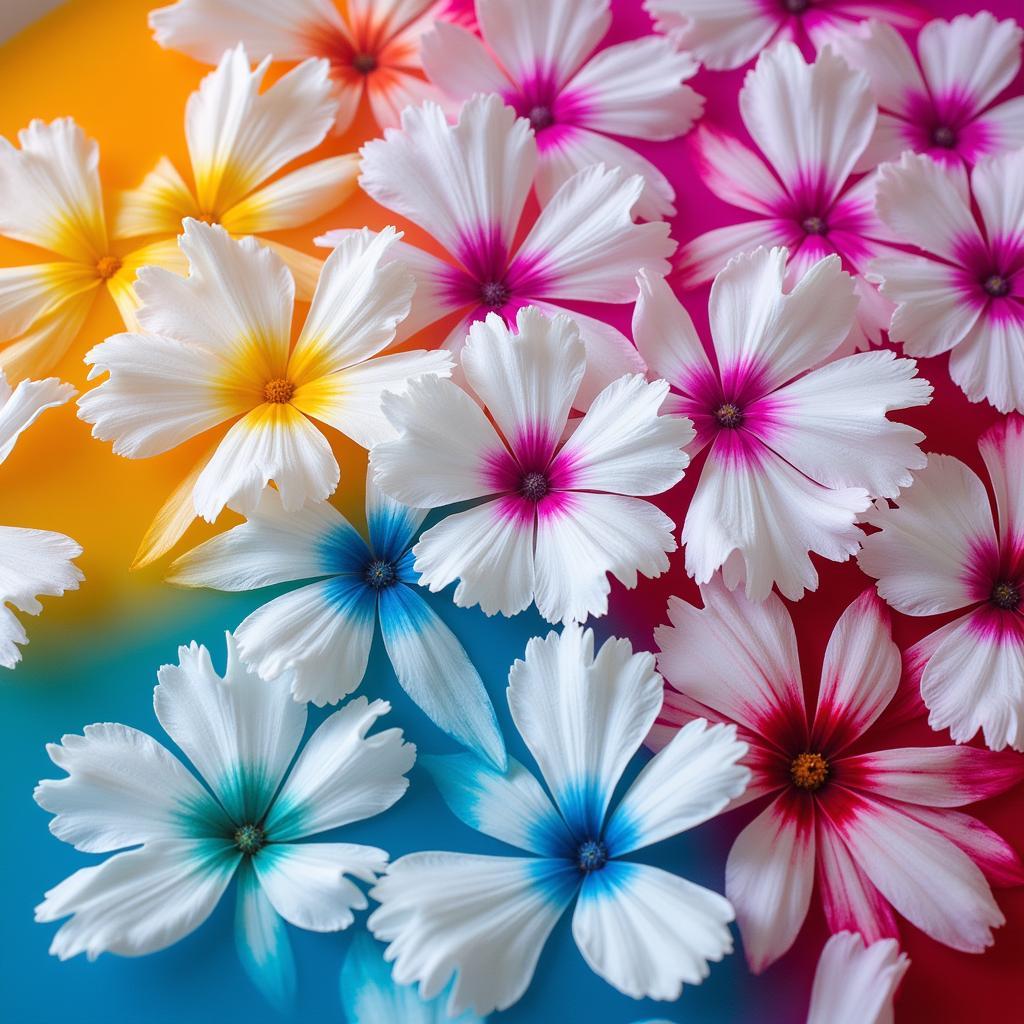Dyeing flowers with food coloring is a fun and easy way to add a pop of color to your home decor or create unique gifts. Whether you’re a seasoned DIY enthusiast or just starting, this comprehensive guide will provide you with all the information you need to transform ordinary flowers into vibrant masterpieces.
Understanding the Basics of Flower Dyeing
Before we delve into the step-by-step process, let’s cover some essential knowledge about dyeing flowers with food coloring:
-
Science of Absorption: Flowers, like many other plants, naturally absorb water through their stems to stay hydrated. This process, known as transpiration, allows for the colored water to travel up the stem and into the petals, resulting in a color change.
-
Best Flower Choices: While you can experiment with various flowers, some are naturally more absorbent and yield better results. White flowers, such as carnations, daisies, and roses, are ideal candidates as they readily take on color.
-
Factors Affecting Color Saturation: The intensity of the color depends on several factors:
- Food Coloring Concentration: More food coloring generally leads to a more vibrant hue.
- Dyeing Time: Longer dyeing periods result in deeper and more pronounced colors.
- Flower Type: Certain flower species naturally absorb color more readily than others.
Materials You’ll Need
Gather the following supplies before you begin your flower dyeing adventure:
- Fresh, preferably white flowers (carnations, daisies, roses, etc.)
- Liquid food coloring in your desired colors
- Glass jars or vases
- Sharp scissors or a knife
- Water
- Optional: Flower food or a sugar solution (to prolong flower life)
Step-by-Step Guide to Dyeing Flowers with Food Coloring
Follow these simple steps to dye your flowers:
-
Prepare Your Flowers: Start by trimming the stems of your flowers at an angle using sharp scissors or a knife. This angled cut increases the surface area for water absorption.
-
Create Your Dye Solution: Fill each jar or vase with water. Add several drops of food coloring to each container, adjusting the amount based on your desired color intensity. For a deeper hue, use more food coloring. Remember, you can always add more color later, but you can’t remove it!
-
Submerge Your Flowers: Place your flowers in the prepared dye solutions, ensuring that the stems are submerged in the colored water.
-
Wait and Observe: Allow the flowers to sit undisturbed in the dye solution for several hours or even overnight. Observe the color change periodically. The longer you leave them, the more vibrant the color will become.
-
Optional: Enhance Color Absorption: For faster and more intense results, you can split the stem a few inches upwards from the bottom. This technique creates multiple channels for water absorption.
 Flower Dyeing Process
Flower Dyeing Process
Tips and Tricks for Stunning Results
- Use Warm Water: Warm water is absorbed more readily by flowers than cold water, resulting in faster and more vibrant dyeing.
- Experiment with Color Combinations: Don’t be afraid to get creative! Try mixing different food coloring colors to create unique shades and gradients.
- Add a Touch of Vinegar: A teaspoon of white vinegar added to the dye solution can help the flowers absorb the color more effectively.
- Consider Flower Food: To prolong the life of your dyed flowers, add a flower food tablet or a solution of sugar and water to the vase after dyeing.
Frequently Asked Questions (FAQs)
Q1: Can I dye any type of flower?
While you can experiment with various flowers, white flowers with soft stems, like carnations and daisies, tend to yield the most vibrant results.
Q2: How long does it take to dye a flower?
The dyeing time can vary depending on the type of flower and the desired color intensity. You can expect to see noticeable results within a few hours, but leaving the flowers overnight will produce deeper and more vibrant hues.
Q3: Is food coloring safe for flowers?
Yes, food coloring is generally safe for flowers and won’t harm them. However, using too much food coloring can potentially clog the flower’s stems, hindering water absorption.
Q4: Can I re-dye flowers that have already been dyed?
While you can attempt to re-dye flowers, the results may not be as vibrant, and the original color might affect the new hue.
Conclusion
Dyeing flowers with food coloring is a delightful and accessible way to infuse your living spaces with color and personality. By following these simple techniques and allowing your creativity to blossom, you can transform ordinary blooms into extraordinary works of art.
If you’re eager to explore more creative DIY projects or need expert advice on transforming your living spaces with color, our team at Color Box Hanoi is here to assist you. Contact us at Phone Number: 0373298888, Email: [email protected], or visit us at 86 Cầu Giấy, Hà Nội. Our dedicated customer support team is available 24/7 to answer your queries and provide tailored solutions.

